

| Building The Boeing B52 For The Slope (Part 2) |
Clwyd Soaring Association
(Click Here for Part One)
Finishing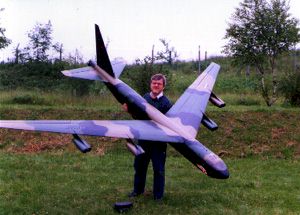
The project was now into its second year and the unmistakable shape of
the Stratofortress had emerged. Attention was then given to covering methods
and a suitable colour scheme.
After a great deal of consideration one of the heat shrink fabric coverings was chosen. In this case it was Polytex. The airframe was given a coat of Balsaloc prior to covering and this mammoth task duly commenced. After application the Polytex was given two coats of 50/50 thinned clear dope and cellulose thinners, this prevents any bubbling on the fabric later. This is purely personal, but one that works well.
A superb three view complete with colour scheme was found after searching by friends and club mates. This was to be a three tone top surface camouflage with an all black under surface; the fin and rudder were also black. Interesting to note this version had sharks teeth on the front lower fuselage, which I'm sure, smiles at me every now and then!
Difficulty was experienced in obtaining commercially produced paints in the correct colours but this was overcome by mixing Powermax paints to obtain the required shades. A 50/50 mix of paint and Powermax thinners was used. The viscosity of the paint was just right.
The base colour was sprayed on using a Badger 200 airbrush. The two remaining colours followed this. Panel lines were drawn on using several sizes of Rotoring mapping pens. The airbrush was then used to apply a "weathering" effect. I always go very carefully here as one can overdo this and end up with a very clinical and unrealistic finish.
Markings were masked and sprayed individually. Insignia were photocopied, reduced to scale size, and then hand painted to produce a very realistic appearance. On completion of the colour scheme, a coat of Ronseal was applied, satin and matt finishes being mixed in equal parts and thinned with a good quality white spirit before being sprayed on. I was fortunate to have the use of a large empty building in which to spray the B52. Without this facility I would have had real problems. The time in which it took me to spray this machine was sixteen days; obviously this was working just a few hours at a time.
Radio
Installation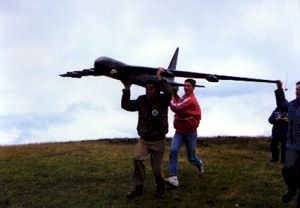
With eight on board servos, the extension cables proved to be very long
indeed. Advice to fit a choke into each extension lead on the signal lead
of each servo close to the receiver was gratefully accepted. Without these,
the long length of the cables could cause them to act as aerials and give
interference problems. The battery pack, which was housed in the hollow
balsa nose cone, was of the 1200 mAh type. The receiver was packed in
foam rubber and placed in a full-length box situated within the fuselage.
Final
Touches
To complete the model, navigation lights were fitted and these enhance
the now very realistic appearance. The model weight is 24 lbs 12 oz. As
the estimated all up weight at the commencement of the project was between
22lbs and 25 lbs the final weigh?in gave me much delight. (A truss was
ordered for the poor old sod that was to launch it). Centre of gravity
was spot on. No ballast weight would be required at all.
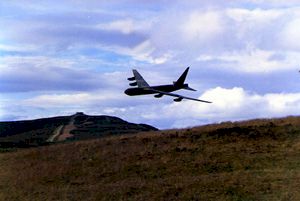 Maiden
Flight
Maiden
Flight
The initial flight took place in early May, after waiting several weeks
for a suitable weather slot. The day in question was bright and clear
with an ideal 15-knot westerly wind on the Moel Famau ridge in Clwyd,
North Wales.
Club mate Alan Miller supplied the transport in the shape of a purpose built model trailer and a good selection of club mates acted as 'sherpas' to carry the gigantic model to the launch site.
Rigging the model is a relatively simple operation. A radio check was carried out, and followed by control checks. Everything was working perfectly and I ran out of excuses to delay the big moment any further. I opened the Valium bottle and tightened my bicycle clips. Four strong club members raised the model above their heads. At a nod from me, they ran forward a few paces and the B52 was airborne. The model lurched forward and then upwards, akin to a homesick angel. I was relieved and delighted to discover that the C of G was spot on.
She looked every inch a thoroughbred in the air, the large size of the model created a very realistic vision.
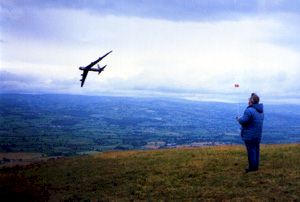 Elevator,
aileron and rudder responses were very smooth. I discovered that turns
were better using co?ordinated aileron and rudder. After about fifteen
minutes the effect of the flaps was tested. Anything up to 15º of
positive flap produced a massive amount of lift with very little loss
of forward speed. Greater than 15º however produced a decrease in
speed but with no loss of pitch or roll response (in fact a stall, in
the true sense of the word, has not been achieved). Application of full
'up' elevator produced a pronounced "mush". With the application
of flap, a nose up attitude took place but with a little forward elevator
stick this was no problem.
Elevator,
aileron and rudder responses were very smooth. I discovered that turns
were better using co?ordinated aileron and rudder. After about fifteen
minutes the effect of the flaps was tested. Anything up to 15º of
positive flap produced a massive amount of lift with very little loss
of forward speed. Greater than 15º however produced a decrease in
speed but with no loss of pitch or roll response (in fact a stall, in
the true sense of the word, has not been achieved). Application of full
'up' elevator produced a pronounced "mush". With the application
of flap, a nose up attitude took place but with a little forward elevator
stick this was no problem.
One manoeuvre, which is mandatory, is landing. I decided to attempt some landing circuits with overshoots to check out the B52's approach behaviour. This proved to be excellent, and a landing was called. Crosswind, downwind, base leg were completed and on finals. Small amounts of flap deflection was used to the final touch down point. The B52 landed with very little forward speed and slid across the grass to come to rest amid applause from the spectators. If I told you I felt good at that moment it would be the greatest understatement of the year. A bottle of bubbly (lemonade) was broken open to celebrate the momentous occasion.
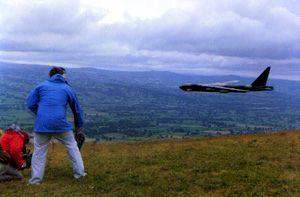 The
B52 has since logged up many hours airtime since the first flight and
in all sorts of varying conditions and sites. The aircraft is at home
in 12 to 15 m.p.h. winds and over, its soaring capability has to be seen
to be believed! I have felt, whilst flying this machine that its ability
to manoeuvre is so good that it would perform a roll. However I did not
mention this to fellow flyers just in case they thought I was insane!
This desire to roll the B52 got the better of me and in April whilst flying
at the Horseshoe Pass, this overwhelming desire got the better of me.
I had been flying around for about fifteen minutes in good lift and following
a pass into wind, heading away from the slope. I applied a little up elevator
to take the nose above the horizon this was followed by full left aileron
and a little left rudder and she rolled beautifully showing no tendencies
to barrel. (If I'd have used more rudder this may have happened).
The
B52 has since logged up many hours airtime since the first flight and
in all sorts of varying conditions and sites. The aircraft is at home
in 12 to 15 m.p.h. winds and over, its soaring capability has to be seen
to be believed! I have felt, whilst flying this machine that its ability
to manoeuvre is so good that it would perform a roll. However I did not
mention this to fellow flyers just in case they thought I was insane!
This desire to roll the B52 got the better of me and in April whilst flying
at the Horseshoe Pass, this overwhelming desire got the better of me.
I had been flying around for about fifteen minutes in good lift and following
a pass into wind, heading away from the slope. I applied a little up elevator
to take the nose above the horizon this was followed by full left aileron
and a little left rudder and she rolled beautifully showing no tendencies
to barrel. (If I'd have used more rudder this may have happened).
Subsequent flights have taken place and further rolls to the right and left have been executed with no difficulty even four point rolls are good!
The Stratofortress has even been flown inverted and although I realise these antics are not scale the B52 performs them with a sort of grace and beauty.
Twelve delayed parachute bombs have been made and these are stacked in the bomb bay and are released on a low pass up wind of course! The chutes deploy on leaving the aircraft and usually all the kids present have a great time retrieving them. It's wise to have some candy on hand as a reward!
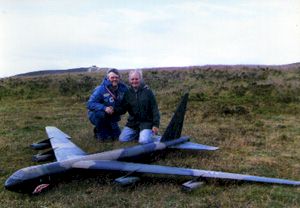 The
flaps have an amazing effect. As expected, when these are lowered a nose
up attitude occurs, anything up to 15º and the B52 goes up in an
alarming fashion When lowered more than this forward speed deteriorates
and the nose needs to be pushed down more, the aircraft is now in a steady
decent, more down flap greater the decent angle.
The
flaps have an amazing effect. As expected, when these are lowered a nose
up attitude occurs, anything up to 15º and the B52 goes up in an
alarming fashion When lowered more than this forward speed deteriorates
and the nose needs to be pushed down more, the aircraft is now in a steady
decent, more down flap greater the decent angle.
A combination of pitch and flap control, one can achieve landings with very little forward speed and a high degree of accuracy. With aileron and rudder "crossed" it is possible to side slip the Stratofortress onto awkward sites such is the response to all the controls. Pitch if anything, is the least sensitive but I believe this is due at this stage to a slightly nose heavy situation which of course can be rectified.
Having had the B52 for some time it's become easier to transport to and from the different flying sites. Assembling is easy as I mentioned earlier, when people ask was it all "worth it" my answer of course is yes. When the B52 is on the wing in a low pass climbing out gently, it makes the hair on the back of your neck stand on end.
The wonders of flight!
(Click Here for Part One)
This article was contributed by
Ray Jones
Clwyd Soaring Association